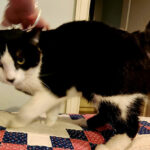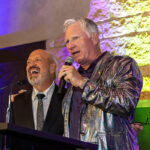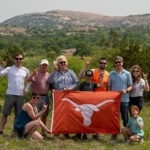Two Longhorns Spark Discovery at the Hill Country’s Science Mill

One Wednesday last September, four buses from Boerne Middle School North pulled up to the Science Mill in the heart of Johnson City. One hundred and fifty sixth graders bounded into the museum, a former 1800s grist mill on the corner of South Lady Bird Lane and Main Street. Some raced to see the zebrafish and African spurred tortoises. Others squealed en route to the Colossal Robotic Hand, a 26-foot-tall appendage equipped with a remote joystick to manipulate its gigantic fingers. The Fossil Dig drew a big crowd outdoors, as 12-year-old paleontologists unearthed stories of plants and animals that lived 70 million years ago.
Every inch of this wacky wonderland exposes young minds to big ideas in engineering and earth, energy, computer, and life-science. “We thought that those were broad subjects and that many disciplines would fall within them,” says Holly Barton, BS ’02, Life Member, the museum’s director of strategic alignment and a founding staff member.
The sleepy Hill Country may seem an unlikely place to host such a bustling hub of scientific activity. Yet the location appealed to the museum’s creator, Bonnie Baskin, a microbiologist and entrepreneur who moved to Johnson City from Minnesota in 2010. When Baskin noticed the derelict feed mill for sale on Highway 290 in 2012, she bought it. She wanted to build a place where kids from small towns could learn about careers in science, technology, engineering, and math. Johnson City had a dearth of STEM programs for local students and was also accessible to schools in Austin, Fredericksburg, San Antonio, and Dallas. Baskin especially liked the idea of springing a science mecca from the mill, a landmark that was once owned by Lyndon Baines Johnson’s uncle, James Polk Johnson.

In 2013, Baskin hired Barton, who had previously worked at the American Museum of Natural History, to help hone her vision for a state-of-the-art STEM museum. For the next two years, the women worked together with a small team to renovate the historic site and plot unique scientific exhibits. They combed creative spaces worldwide for inspiration. The idea for the Dream Table, a coding and programming exhibit, came from the Children’s Museum of Houston. The Virtual Body Table, which allows students to perform virtual autopsies on animals and humans, came from a design company in Sweden. More than half of the Science Mill’s exhibits were custom built and are one-of-a-kind.
“We just started planning,” Barton remembers. “There was so much entrepreneurial spirit, and things moved fast.” Barton has remained a driving force of that momentum, shrewdly raising and managing museum funds.
Since it opened in February 2015, the Science Mill has welcomed nearly 200,000 school children and adults from across Texas. Many of the visitors are third through ninth graders from economically disadvantaged schools who visit the museum on field trips or through its STEM career summer camp program; 73 percent of campers come from low-income families and attend sessions on scholarships. The week-long day camps transpire at the Science Mill and in small South and Central Texas communities. “We do camp in a box,” Barton says. “We take our instructors and activities to rural areas to target kids who live in STEM deserts.”
Youngsters who visit the Science Mill love the interactive displays. At the outdoor Science & Art Park they can play tug-of-war on a giant lever and learn about force. In the BioLab, they can take the pulse of a zebrafish embryo, inflate a pig lung, and observe axolotl salamanders—endangered amphibians that can regenerate their own limbs and organs. The 3-D theater and Aquaponics Greenhouse receive constant foot traffic. No exhibit bears much text or lengthy explanation, including those inside the Mill’s original silos. “We want kids to be curious, to figure out how things work and to know it’s OK to fail,” Barton says.

Not far from the Incredible Ball Machine, a giant outdoor labyrinth of ball chutes and loops, Science Mill Creative Director Zac Zamora tinkers in his 5,000-square-foot workshop. After graduating from UT in 1999 with a degree in zoology, Zamora worked as a herpetologist at the National Aquarium in Baltimore, where he built animal habitats and maintained exhibits. Five years later, he started fashioning similar structures for private clients. Soon his endeavors grew into his business, Variance Design, which specializes in building living walls using hydroponics to grow dozens of plant species for clients like Amazon, the American Museum of Natural History, and the San Diego and Houston zoos. “I had a lot of aquariums as a kid growing up in El Campo, Texas, and I always had a passion for building structures to hold living things,” he says.
In January 2016, a few years after Zamora moved back to Texas, the Science Mill hired him to build a paludarium—it looks like an aquarium and contains an ecosystem of terrestrial and aquatic elements—in its lobby. That gig turned into a permanent position. Today, Zamora combines science, design, carpentry, sculpting, welding, metal work, electronics, and circuitry to create new exhibits for the museum. His imagination is reflected in the robotic hand, wave pendulum, tortoise habitat, greenhouse, and more. “He’s the real story here,” Barton says.
As the Boerne sixth graders file out to their buses, they look exhausted but content. “They love that they can explore the Science Mill at their own pace, that they can touch the exhibits,” says Jennifer Alexander, a Boerne Middle School North teacher who has brought her classes here five years in a row. Today her students learned how to code to make a robot move. “They see things here that they may never see back at school or at home,” she says.
Johnson City has come full circle. Once a place of industrial production, it can now produce scientists to lead the next generation. “The heart of the Science Mill is giving people the opportunity to have science in their lives,” Barton says. “Kids from rural communities deserve as much exposure to STEM subjects as kids from Austin or San Antonio.”
Photographs by Joel Calvin

















1 Comment